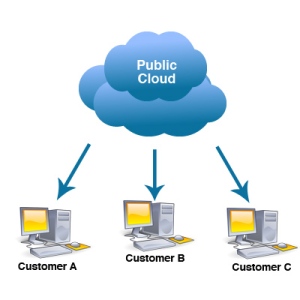Public Clouds are owned by the cloud vendors, the computing
infrastructures are hosted at the vendor’s premises. In this kind of
deployment Cloud is made available in pay-as-you-go manner to the
general public. The customer has no visibility of where the computing
infrastructure is hosted.
The customer experiences the service as if the resources are used from their desktop and are abstracted from how cloud works. The cloud resources are shared among multiple customers, cloud providers offer a variety of options in pricing, performance, and feature set. With public clouds the customer can use only or any of the services provided by cloud, services may be AaaS, SaaS, PaaS or IaaS. Customer need not worry about the infrastructure to be setup or need not pay a large upfront cost (e.g., for hardware cost) before purchasing any services nor over-provision resources to accommodate future or peak demand.
A primary benefit of going for public cloud is economics. Since they are by necessity, optimized for minority peak-load times, data centers are underutilized the majority of the time. Even the customer has no hassle of looking out for extra capacity of servers or apply a thought on cost cutting measures, nor think about maintaining and dealing with wear and tear of infrastructure. The public can go green by preserving the nature’s gifts by using resources as needed. Since power, cooling and physical plant costs are reduced, low operations costs.
A growing number of companies are riding this wave to provide public cloud computing services, such as Amazon, Google, Microsoft, Rackspace, and GoGrid & many more google it. A well-known consumer version of a public cloud application is the iTunes Store.
Pros and Cons
Public Cloud is a low cost option for customers since it is a shared capability. It provides an ideal platform for rapid proofs of concept, on-demand performance testing, and document and information collaboration through technologies such as Google Doc’s, docstoc.com, Flicker.com. The major downside of this cloud computing model is the location and security of proprietary information. Public cloud offerings are essentially public (rather than private) networks, exposing the system to more attacks. One issue is that vendor cloud administrators have access to data creating theft or abuse risks. The location of data is also of great consequence since it determines under which laws the information resides. Another major concern is data recovery. Most public cloud servers are not built for high availability or automatic failover. As a result, enterprises may be forced to spend additional monies for a backup or failover environments. In addition, because of the utility nature of the public cloud model, vendors cannot provide meaningful Service Level Agreements.
The customer experiences the service as if the resources are used from their desktop and are abstracted from how cloud works. The cloud resources are shared among multiple customers, cloud providers offer a variety of options in pricing, performance, and feature set. With public clouds the customer can use only or any of the services provided by cloud, services may be AaaS, SaaS, PaaS or IaaS. Customer need not worry about the infrastructure to be setup or need not pay a large upfront cost (e.g., for hardware cost) before purchasing any services nor over-provision resources to accommodate future or peak demand.
A primary benefit of going for public cloud is economics. Since they are by necessity, optimized for minority peak-load times, data centers are underutilized the majority of the time. Even the customer has no hassle of looking out for extra capacity of servers or apply a thought on cost cutting measures, nor think about maintaining and dealing with wear and tear of infrastructure. The public can go green by preserving the nature’s gifts by using resources as needed. Since power, cooling and physical plant costs are reduced, low operations costs.
A growing number of companies are riding this wave to provide public cloud computing services, such as Amazon, Google, Microsoft, Rackspace, and GoGrid & many more google it. A well-known consumer version of a public cloud application is the iTunes Store.
Pros and Cons
Public Cloud is a low cost option for customers since it is a shared capability. It provides an ideal platform for rapid proofs of concept, on-demand performance testing, and document and information collaboration through technologies such as Google Doc’s, docstoc.com, Flicker.com. The major downside of this cloud computing model is the location and security of proprietary information. Public cloud offerings are essentially public (rather than private) networks, exposing the system to more attacks. One issue is that vendor cloud administrators have access to data creating theft or abuse risks. The location of data is also of great consequence since it determines under which laws the information resides. Another major concern is data recovery. Most public cloud servers are not built for high availability or automatic failover. As a result, enterprises may be forced to spend additional monies for a backup or failover environments. In addition, because of the utility nature of the public cloud model, vendors cannot provide meaningful Service Level Agreements.

No comments:
Post a Comment